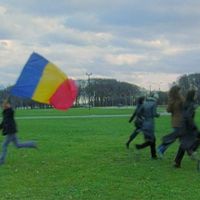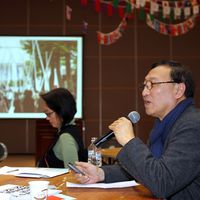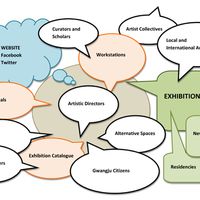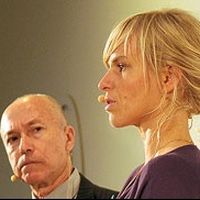10000 Lives: the 8th Gwangju Biennale
 [caption id="attachment_6617" align="alignright" width="355" caption="Gwangju Biennale"]
[caption id="attachment_6617" align="alignright" width="355" caption="Gwangju Biennale"]The significant development of contemporary Asian art on an international circuit can be traced through the continuous increase of Biennales and Triennales in Asia after the first Gwangju Biennale in 1995. The Gwangju Biennale was the first international art biennale in Asia to be introduced as such to the international community and has established itself as Asia’s oldest and most prestigious Biennales of contemporary art. It is amongst the world’s “most visited” Biennales and attracts a huge international audience every year – alternating between art and design.
Through cultural exchange on an international level, the Gwangju Biennale aims to provide a central voice for Asian art, while being the cultural axis which connects the east to the west. With future editions of Art Gwangju and other projects developing under the umbrella of the Gwangju Biennale Foundation, there is a certainty of increasing not only the numbers but also variety in audience from artists, students and art enthusiasts to collectors, museums and galleries.
Gwangju is headed to become Asia’s representative city for culture and art.
10000 Lives – The 8th Gwangju Biennale
This year, Massimiliano Gioni, Artistic Director of the Gwangju Biennale Foundation paid tribute to the 30th anniversary of the Democratic Uprising by naming the 8th Gwangju Biennale, 10000 Lives.
The title was borrowed from Korean author, Ko Un’s 30 volume epic poem, Maninbo (Ten Thousand Lives). Un began writing Maninbo in 1980 when he was arrested during the Uprising and completed it earlier this year. Maninbo contains written portraits of all the people he met during his lifetime. Similarly, the 8th Gwangju Biennale directed by Gioni was centred on the portrayal of images and their effects on and relationships with people.
According to Gioni, the images exist “first and foremost as traces and relics; as evidence of lives lived, lives that – like the many lives in Maninbo, like every life – are worth remembering. These images are all that remains of those lives. These images are themselves the only survivors.”
Gioni converted the Biennale Hall and its surrounding venues into a temporary museum-like space. The Biennale structure was very well executed and curated so as not to make the over-powering imagery of the various art forms in the exhibition too jarring. There was a blurring of boundaries between documents, historic relics and art works.
The five galleries of the Biennale Hall explored photographic representation , mechanics of vision, representation of heroes and martyrs, depiction of idols and religion and an insight into cinema and television. The exhibition section at Gwangju Folk Museum concentrated on works that addressed the interaction of images and memory, while the display at the Gwangju Museum of Art focused on self-portraiture and images as projections of the self.
Besides a detailed and informative 500-page illustrated catalogue, a satellite publication of the 8th Gwangju Biennale was a book edited by Gioni himself, entitled I’m Not There. The book comprises works by 190 artists from over 30 Asian countries. It performs the function of a geographical research anthology on Asian art. Gioni described his satellite project as an introduction to “a multiplicity of artists and art worlds that are too big to be grasped by a single mind and too diverse to be easily summarised in one single taste.”
The Gwangju Museum of Art
Since 2004, the Gwangju Museum of Art and the National Taiwan Museum of Fine Arts (NTMOFA) have been collaborating to showcase contemporary art from Taiwan alongside the Gwangju Biennale. They became sister institutes in 2008 to internationally promote Korean and Taiwanese contemporary artists.
Hsiao-Yu Lin, the curator at NTMOFA, said that this collaboration has helped build connections between Korea and Taiwan, and has also given Taiwanese artists exhibiting there an opening into the international art world.
The Gwangju Biennale Foundation
[caption id="attachment_6619" align="alignright" width="356" caption="Gwangju Biennale"]
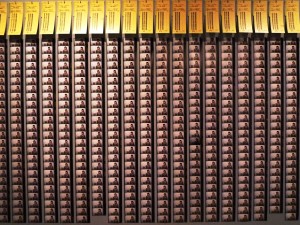 [/caption]
[/caption]The Gwangju Biennale Foundation (GBF) is non profit organisation which organizes and manages several events that take place around the city. Earlier this year, The Flower of May, curated by Yongwoo Lee was co-sponsored and organised by the GBF. This exhibition of international contemporary art opened with a symposium, comprising of renowned curators and art practitioners, who discussed various aspects of the international art world, from art movements to the art market.
Another exhibition – Emerging Asian Artists – hosted by the GBF was held alongside the first edition of Art Gwangju and was carried out by the Department of Special Projects of the GBF. The exhibition, curated by Yongwoo Lee, comprised of works by twenty-two contemporary artists from eight Asian countries, the primary criteria being that all artists were under the age of forty. The exhibition was accompanied by a more detailed publication introducing the works of eighty emerging Asian artists, along with essays discussing Asian art in a local and international context by Yongwoo Lee, Carol Yinghua Lu, Maurizio Bortolotti and myself.
The GBF has also hosted two editions of the International Curator course. This programme is chaired by Yongwoo Lee (Vice-President of the Gwangju Biennale) and has developed an international network of young curators who have collaborated on various projects and curatorial incentives across the globe.
Gwangju – Asia’s Art and Culture Hub
The Korean government has initiated the largest project in the history of the nation – it is to make Gwangju the Hub City of Asian Culture and the fulcrum of cultural exchange and development in Asia, so as to open international avenues.
The Kunsthalle Gwangju opened with the Swiss artists’ group, Etoy, on 31st August 2010, just before Art Gwangju and the Gwangju Biennale and was co-hosted by the Hub City of Asian Culture. The exhibition is at a temporary space made of cargo containers. This space will eventually be the Asia Culture Complex, which is set to open in 2012.
References:
10000 Lives; Gwangju Biennale 2010 catalogue; The 8th Gwangju Biennale
Emerging Asian Artists, Art Gwangju 2010; Publication by the Gwangju Biennale Press
About the writer:
Veeranganakumari Solanki based in Mumbai, India; is an art-writer, researcher and curator; and a contributing editor to TAKE on Art magazine. She studied English Literature (B.A.), holds post-graduate diplomas in Indian Aesthetics (2007) and Art Criticism and Theory (2009) as well as a Masters in History (2009). She was a participant of the 1st Gwangju Biennale International Curator Course (2009) and has served as a curatorial assistant at Bodhi Art Gallery, Mumbai and as an art analyst, researcher and curatorial assistant at the India Art Fund.
Recent curatorial experience – NINE: Her Magic Square (The Viewing Room, Mumbai); Feminine Recitals (Exhibit 320, New Delhi); Emerging Asian Artists, Gwangju (co-curator and contributing writer); Spectrum India, Abu Dhabi (2009, Assistant Curator)
Similar content
from - to
03 Sep 2010 - 07 Nov 2010
deadline
15 May 2012
posted on
15 Aug 2011
deadline
25 Jun 2018

